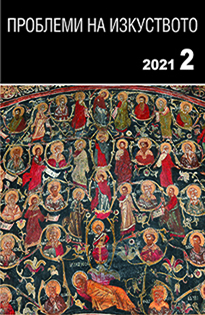Свитъците на монаси и светци в южната галерия на митрополитския храм „Св. св. Петър и Павел” във Велико Търново
Scrolls of Monks and Saints at the South Aisle of the Metropolitan Cathedral of Sts Peter and Paul in Veliko Turnovo
Author(s): Tsvetan VasilevSubject(s): History, Fine Arts / Performing Arts, Visual Arts, Modern Age, 16th Century, History of Art
Published by: Институт за изследване на изкуствата, Българска академия на науките
Keywords: post-Byzantine epigraphy; mural inscriptions; Greek inscriptions; post-Byzantine art
Summary/Abstract: There are two thematic focuses at the south aisle of the Metropolitan Cathedral of Sts Peter and Paul in the city of Veliko Turnovo: a calendric cycle and below are representations of monks and saints. Well-preserved are only fourteen of them, where only St Simeon Stylites holds not a scroll. The monastic representations aregrouped into three: the first group facing east begins with an unidentified saint, probably St Anthony the Great, judging by the restoration of the half-damaged inscription. Next come St Euthymius holding a scroll containing a passage of his own vita written by Cyril of Scythopolis, and St Athanasius with a scroll with part of the life of St Pachomius the Great on it. The second group features the representations of St Sabbas the Sanctified, St Hilarion the Great and St Theodosius the Cenobiarch. The texts inscribed in their scrolls convey strong messages to the readers from monastic practices. These texts are recorded in the popular hermeneiai in Greek, the so-called First and Second Jerusalem Manuscripts. The scroll of St Theodosius is unusually folded in half with the closing two lines of the text inscribed overleaf and read from top to bottom. The third group includes the Sinaitic monks St Nilus of Sinai, St John of the Ladder (Climacus) and St Simeon Stylites. The text on the scroll of St Nilus conveys a message of renouncing one’s will and achievingimpassibility, and that of St John of the Ladder the practice of virtue.The fourth group includes the representations of St Cyriacus the Anchorite, and unidentified saint (probably St Theodore the Studite) and St Maximus the Confessor. St Cyriacus forewarns unmindful monks and Christians of being vigilant at all times and “stand aloof from the world” so that to avoid falling prey to the “night mind thief”. St Theodore the Studite (?) holds a text on constant prayer and gratitude as a means to be blessed by God for good works. St Maximus the Confessor also reminds constant prayer and gaining an insight into love. The primary source of his message is the ascetic Capita de caritate (Four Hundred Chapters on Charity), compiled by St. Maximus the Confessor. The explanatory inscriptions of the last two representations are damaged. The first saint is, in all likelihood, St Cosmas of Maiuma, holding a scroll with a passage from the canon of Maundy Thursday. The second saint holds a text also borrowed from Capita de caritate by St Maximus the Confessor.
Journal: Проблеми на изкуството
- Issue Year: 2021
- Issue No: 2
- Page Range: 42-50
- Page Count: 9
- Language: Bulgarian
- Content File-PDF

